Guest Editorial
93
Guest Editorial
Developing Interdisciplinary
Problem Solving
Chris Arney
Dept. of Mathematical Sciences
U.S. Military Academy
West Point NY 10996
david.arneySusma.edu
Disciplinarity
Academe is fixated on disciplinary depth and specialization. People
have a tendency to gravitate to their interests and focus their learning to-
ward one most-comfortable academic discipline. If successful enough, they
become experts (specialists) in their chosen discipline. In this disciplinary-
based academic world, the more advanced a student's learning, the more
narrow (but deeper) are her interests and skills. The common phrase is that
she becomes "an inch wide and a mile deep."
Universities and many colleges, through their discipline-based depart-
ments, educate these experts at various levels of degrees. Society rewards
holders of these degrees with positions that sometimes have something to
do with the person's academic discipline. But a tight discipline-skill match
does not always happen. Why? Narrow academic disciplines do not al-
ways match the broader job-skills and professional needs all that well.
For many universities and colleges, that limitation does not matter —
having their graduates obtain a good job is what matters. Traditionally,
employers are not as happy with this academic disciplinary focus, but they
have little choice but to accept the best available, narrowly educated gradu-
ates. Professional education and on-the-job training reduce this discipline-
skill gap and eventually create a person who is suited to the job of solving
the broader, more complex real-world problems.
The UMAP Journal 34 (2) (2013) 93-101. ©Copyright 2013 by COMAP, Inc. All rights reserved.
Permission to make digital or hard copies of part or all of this work for personal or classroom use
is granted without fee provided that copies are not made or distributed for profit or commercial
advantage and that copies bear this notice. Abstracting with credit is permitted, but copyrights
for components of this work owned by others than COMAP must be honored. To copy otherwise,
to repubHsh, to post on servers, or to redistribute to lists requires prior permission from COMAP.
�
94 The UMAP Journal 34.2(2013)
We frequently encounter this discipline-focused academic environment.
The first thing one asks a person attending a university or college is what
is her major. The hope and expectation is to hear a well-known, highly-
regarded discipline in the response. Most reading this editorial would
smile if at that inquiry the stated discipline was "mathematics." Perhaps
some would frown if the response was "interdisciplinary studies".
Depth-Breadth Considerations
what are the disciplinary requirements of society? Does society really
need and use fhese specialists, or is there something more that meets the
needs of society than academic disciplinary focus, degree categorization,
professional preparation, and confining specialization? What about multi-
disciplinary, interdisciplinary, transdisciplinary, and cross-disciplinary skills,
plus the need for more intellectual breadth and knowledge-integration
skills, in student learning? Is this depth-breadth issue just a difference
between liberal arts and professional education? Do any of the broader
academic frameworks have merit or relevance in society?
First, I will consider these questions from problem-solving and concep-
tual points-of-view. Later I will consider more programmatic answers to
these questions.
Transdisciplinarity
Transdisciplinary is when all ideas are immersed or incorporated into
the whole of knowledge. It is the most holisfic view of knowledge. In a
sense, it is the complete absence of disciplinary focus. Transdisciplinary is
an extreme view of knowledge, information, and problems that limits the
world to a generalist or holistic viewpoint without any role for specializa-
tion. While there are instances where the generalist or polymath is valuable
to problem solving, it is difficult to imagine that a transdisciplinary ap-
proach would be the only way to solve all or even many societal problems.
This transdisciplinary concept was derived from the ideal in Renaissance
humanism, when several centuries ago it was thought that it was possible
to acquire a universal learning without the restrictions of learning specific
academic disciplines. A skilled generalist can develop an open mind with
the skills to understand and articulate relationships between disciplines.
Transdisciplinary is portrayed as producing inch-deep, mile-wide gradu-
ates. The concepts and terms "transdisciplinary" and "generalist" directly
contrast "disciplinary" and "specialist."
�
Guest Editorial
95
Cross-disciplinarity
Cross-disciplinary is an entirely different concept. It simply defines or
explains aspects of one discipline in terms of another. It is merely a way to
add a new perspective from a second or different discipline to an existing
disciplinary view and so is limited as a problem-solving framework. Cross-
disciplinary examples are found in courses such as "mathematics for music"
or "history of science." These kinds of course connections may develop
some breadth in understanding, but a cross-disciplinary framework, like
a strictly disciplinary one, is too limited to be empowering for societal
problem solving.
Multidisciplinarity
Let's explore the conceptual frameworks and notions of multidisci-
plinary and interdisciplinary We start with a problem-solving approach.
Some problems lend themselves to a reductionist, divide-and-conquer, ap-
proach. These kinds of problems are perfectly suited to a multidisciplinary
methodology or conceptual framework.
Once divided, the component parts can be considered as disciplinary
problems, where specialization is an advantage or perhaps a requirement.
Once the components are solved, the solution elements are pieced backed
together to provide a complete solution to the problem. In this case, the
multidisciplinary team approach is a powerful and appropriate method of
attack that often leads to success.
This multidisciplinary thinking and problem solving is how society ad-
vanced during the Industrial Age and used its science and engineering
to enhance commerce, to find and produce energy, and to develop new
technologies. Structured processes, such as the scientific method and the
engineering design process, often decipher highly reductionist problems
that are well-suited for the multiple disciplines that call themselves science
or engineering; they use a multidisciplinary process to solve these kinds of
societal (often technical) problems.
Certainly, mathematics, as the science of measurement, is used in that
way for many problems. For those problems, the multidisciplinary ap-
proach of engineering and science methodology is appropriately and ef-
fectively used. Similarly, many of the problems in operations research
and computer science that involve design optimization of an algorithm or
statistical data mining can be effectively attacked using a similar multidis-
ciplinary framework.
�
96 The UMAP Journal 34.2(2013)
Interdisciplinarity
In contrast to the multidisciplinary reductionist approach is holism—
the non-reductionist concepts of complexity theory or systems science. In a
holistic interdisciplinary framework, the properties of the problem are not
explainable or solvable just from the sum or combination of their reduced
parts but from a synergy produced from the interrelations of those parts or
perspectives. The whole is greater than or significantly different from just
the sum or collection of its parts. These properties often include phenom-
ena such as learning, synchronization, self-organization, adaptation, and
emergence.
Reductionism and multidisciplinary problem solving are limited for
problems with high complexity where the integration of ideas dominates,
especially those with the human elements of culture, cognition, and re-
lationships. The reductionist and multidisciplinary approaches are also
limited for networked phenomena, where higher levels or subsets of the
organization exert causal and indirect influence on other subsets or lower
levels. Complexity occurs when many entities interact in different ways so
that the whole takes on a life of its own.
The modern 21st-century Information Age world is full of examples of
complex or "wicked" problems requiring interdisciplinary approaches and
methodologies. Prime examples are problems and questions formed from
the social, biological, and informational sciences involving interactions of
large numbers of diverse or tmique components. These include ecosys-
tems, financial markets, company organizations and functions, urban pop-
ulations, pandemics, government systems and policies, and warfare. The
multidisciplinary framework fails when it inappropriately uses reduction-
ism on these complex systems. These modern-era non-reductive problems
need holistic solutions within a pluralistic philosophy that integrate ideas,
work with large amounts of data, and use interdisciplinary methodologies
by articulating relationships between several disciplines.
One form of this modern approach to problem solving is called eScience
[Hey 2009]. This holistic, non-reductionist approach changes problem solv-
ing from being analytic (one that "breaks apart") to one that is synthefic,
that identifies the patterns, dynamics, influences, and behaviors exhibited
by systems of interaction. Interdisciplinarity and holism are not newly dis-
covered phenomenon. "The whole is more than the sum of its parts" was
an important holistic component of Aristotle's Metaphysics philosophy and
of Gestalt psychology. Today, there are numerous writings on the method-
ologies of complexity theory, systems science and educational programs to
develop interdisciplinary problem solving [Strogatz 2003; Barabasi 2003].
�
Guest Editorial
97
A Key Role for Modeling
Modeling is the glue that makes interdisciplinary prohlem-solving skills pow-
erful and robust.
Of course, we still need to teach reductionist problem solving, and there-
fore disciplinary learning; and using multidisciplinary methodology to
solve appropriate problems has a place in education programs and courses.
However, in today's world, we need more interdisciplinary integrators and
holistic problem solvers. We need interdisciplinary academic programs and
courses that teach and develop complexity theory, systems theory, pluralis-
tic thinking, and holistic problem solving, where students work alone or in
concert to meld together their intelligence into a powerful problem solving
approach [Gardner 2006]. The complexity of society has increased since the
Industrial Age, and therefore we need to teach the more powerful and flex-
ible modeling-based techniques advocated by George Polya [1945]. Polya's
methodology addresses more interdisciplinary, society-relevant, complex,
quantitative and qualitative problems than the scientific method, engineer-
ing design process, reductionism, or multidisciplinary methodology.
Education
Undergraduate learning must reflect the acquisition of knowledge that
is both specialized and broad—deep enough for mastery of a discipline and
broad enough to build relationships among key subject areas, along with
the interdisciplinary integration of knowledge, ideas, theories, methods,
practices, and applications. Education should not be limited to just the
acquisition of more advanced knowledge in key knowledge areas, but must
also include the creative integration of knowledge in science, humanities,
culture and society [Adelman 2011].
How do we develop educational programs that produce students with
these integrafive thinking skills? It is unreasonable to set the goal of under-
graduate education to produce graduates of programs that are a mile wide
AND a mile deep! However, as advocated in the Degree Qualifications
Profile [Adelman 2011], we need a better balance of breadth and depth for
many more students. We need to lessen our focus on disciplinary skills. We
need to give students more experiences in multidisciplinary and interdis-
ciplinary problem solving, and develop graduates with systemic reasoning
in multiple disciplines. We need courses that teach students how to col-
laborate in multidisciplinary teams, and how to think, integrate, and use
holistic and interdisciplinary methodology. Interdisciplinarity overcomes
the limitations of the reductive, siloed problem solving that we traditionally
teach.
The reality is that society's future will driven by holistic, non-reductionist
education. While we are making great strides in advancing technologies
�
98 The UMAP Journal 34.2(2013)
able to capture vast quantities of complex data, and we are racing to develop
tools to make sense of these data, nowhere in the educational system do
we systematically deal with this interdisciplinary issue. Our disciplinary-
based education system is rapidly falling behind our future needs. The
challenge is to transform the way we educate so society can keep pace with
complex problems. Systems and holistic approaches must be emphasized
over reductive and inductive approaches.
Another example of this educational shortcoming is the existence of
many more topics courses than unifying concept courses. Topics courses are
small-scale multidisciplinary frameworks, and unifying courses are more
likely to expose the student to a holistic-like framework.
How?
How do students learn the interdisciplinary framework and develop
holistic problem-solving skills? One way is to develop an understanding of
the internal structure of a discipline and then show and give opportunities
for its interdisciplinary connections. Another is to alternate disciplinary
development with interdisciplinary problem-solving opportunities within
the student's academic program.
The result is an educational concept called "T-shaped skills" that de-
scribe the abilities of students. The vertical bar of the T represents the depth
of skills and expertise in a discipline, and the horizontal bar is the ability
to collaborate across disciplines and apply knowledge in disciplines other
than one's own. These concepts enable students to see knowledge more
as a unified whole, rather than just as a collection of independent topics.
These broader experiences develop more sophisticated modes of thought
so students can tackle more complex problems. To do this, our courses
need to expose students to problems in a variety of interdisciplinary con-
texts that progressively become more complex and therefore require more
multidisciplinary and interdisciplinary problem solving skills.
None of this is to imply that all students need to become interdisci-
plinary. It is apparent that for some problems diverse teams of intellec-
tual specialists forming multidisciplinary teams can be more powerful than
teams of generalists. As explained in Degree Qualifications Profile [Adel-
man 2011], there are several areas of learning at the college level in addition
to the two areas (broad integrative knowledge and specialized knowledge)
that we have discussed. These other knowledge areas include applied
learning, civic learning, and intellectual skills. Each school and program
has its own goals and therefore unique learning profile. And within the
schools, every student progresses toward their own academic goals within
that profile.
Certainly, liberal arts programs already provide more breadth by ex-
posing students to many disciplines. However, I would suggest that many
liberal arts and engineering programs are more multidisciplinary than inter-
�
Guest Editorial
99
disciplinary, with very little in terms of integrating opportunities. It is there-
fore balance and diversity in knowledge and skills that are needed, where
the education programs are designed to develop students with problem-
solving, collaboration, and integration skills that are disciplinary, multidis-
ciplinary, interdisciplinary, transdisciplinary, and cross-disciplinary.
Medicine—An Analogy
In the medical field, we must have specialists for some very disciplinary-
like (focused) health problems—cardiac surgeons for a specific operation,
for example. But we also need people or teams of doctors to work on two or
more physical systems at once—neuromuscular disorders, as an example
of a multidisciplinary medical issue.
However, very often we need interdisciplinary doctors, general practi-
tioners or holistic physicians, who can think about all the physical systems,
environmental factors, and psychological factors when trying to determine
a diagnosis and course of treatment. Once the general practitioner deter-
mines the diagnosis, she may call in a specialist or a multispecialist team;
but the holistic, integrative understanding of the situation needed to be
obtained before the specialist could be used effectively. All these skills are
needed.
A Role for Network and Systems Sciences
One way to teach interdisciplinary problem solving is to use network
and/or systems science to break down traditional silos, to compare and
contrast processes across domains. Interdisciplinarity is the natural state of
these sciences! The study of interdisciplinary sciences can help build pow-
erful holistic problem-solving skills for non-reductionist problems [Stich-
weh 2011]. Using network science, complex systems can be explored and
synthesized to find patterns and properties in complex processes [Morrison
2006]. These patterns can help us understand evolutionary processes, sys-
tem behavior, and modes of structure associated with topics as diverse as
epidemics, organizational management, information percolation, and the
movement of energy within systems.
Network and systems science with their associated quantitative and
qualitafive modeling provide insight into complex systems resistant to anal-
ysis through other more reductionist approaches. These interdisciplinary
approaches use ñexible data structures for mining of complex data sets; and
they create processes to explore the intersections of social and environmen-
tal issues in order to study the factors and causes of famine, war, disease,
and poverty.
�
100 The UMAP Journal 34.2(2013)
Mathematics
The reason for interdisciplinary learning is to build the holistic skills to
tackle society's complex problems. Mathematics (and its associated prose)
is the language of quantitative problem solving. Without the language
of mathematics, science, engineering, technology, and humanities do not
exist. Without the logic of modeling, in both its multidisciplinary and in-
terdisciplinary forms and quantitative and qualitative perspectives, many
problems cannot be solved. However, even more compelling is that by
using mathematical, network, and systems science to reveal the complex-
ity of the world, we realize that the disciplines are connected and must be
integrated using interdisciplinary methodology to solve the most complex
problems we face. In this way, mathematics supports, or connects to, every
course in every department. Mathematical language, along with innova-
tive modeling, acts as the interdisciplinary glue that will help us solve our
future problems and create the valuable knowledge and powerful ideas for
improved organizations and a better society.
Conclusion
Society in 2013 needs its graduates to study, model, and solve problems
using network and systems science concepts by embracing the modern
world's complexity. Our education programs need to teach holistic prob-
lem solving using the interdisciplinary glue of modeling to graduate more
students with stronger T-skills. Developing these skills are the educational
goals incorporated into the Mathematical Contest in Modeling and the In-
terdisciplinary Contest in Modeling.
References
Adelman, Cliff, Peter Ewell, Paul Gaston, and Carol Schneider. 2011. Degree
Qualifications Profile. Lumina Foundation.
Barabasi, Albert-Lazlo. 2003. Linked: How Everything is Connected to Ev-
erything Else and What it Means for Business, Science, and Everyday Life.
Cambridge: Plume.
Gardner, Howard. 2006. Multiple Intelligences: New Horizons. New York:
Basic Books.
Hey, Tony; Stewart Tansley, and Kristin Tolle (eds.). 2009. The Fourth
Paradigm: Data-Intensive Scientific Discovery. Mountain View, CA: Mi-
crosoft Research.
�
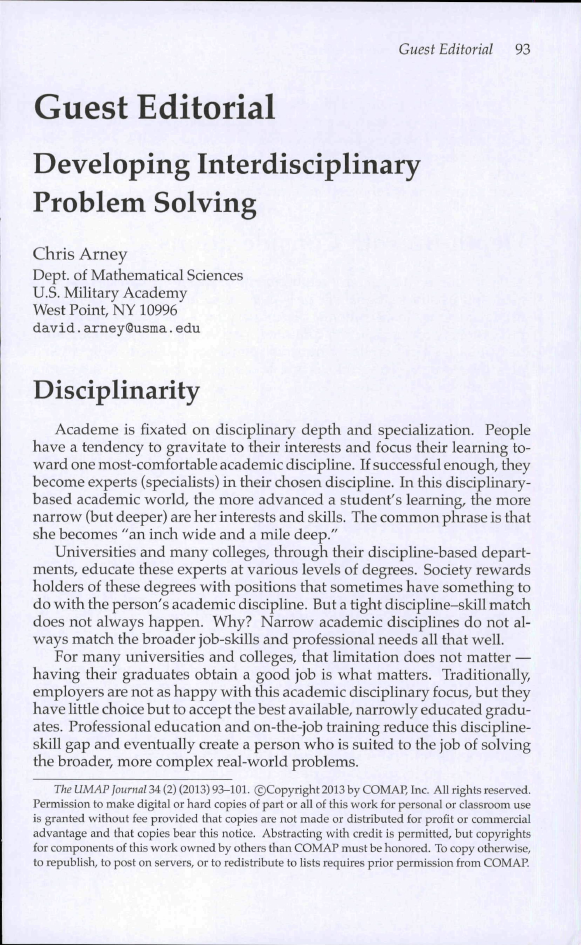
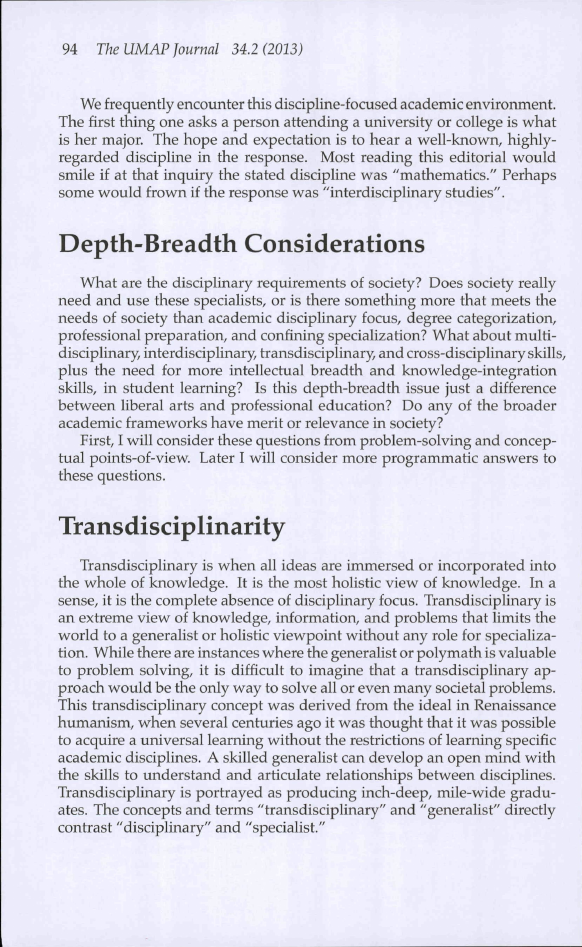
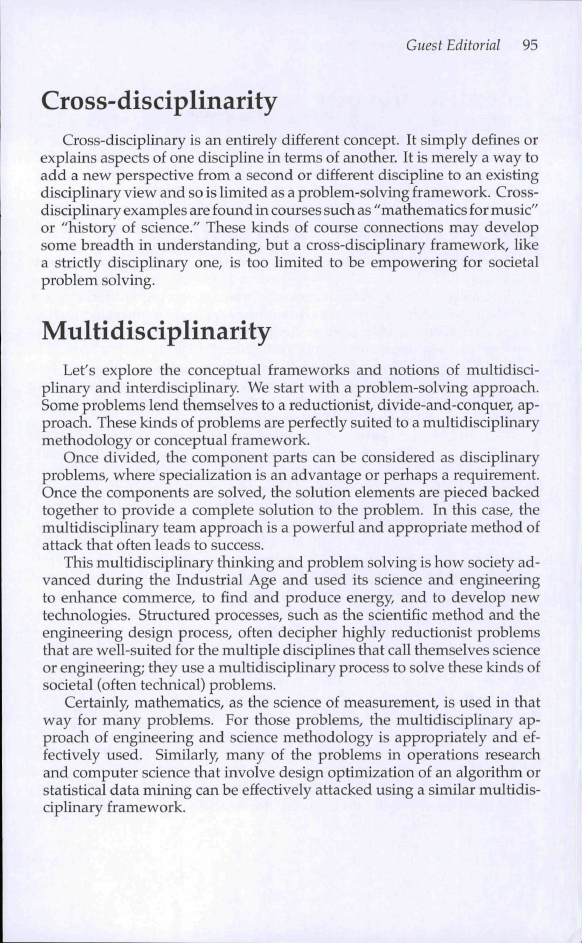
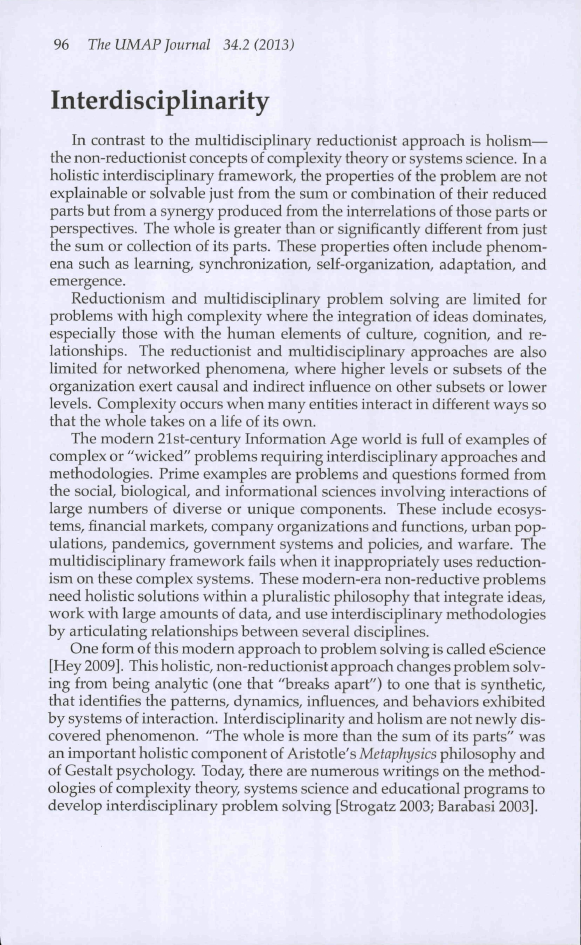
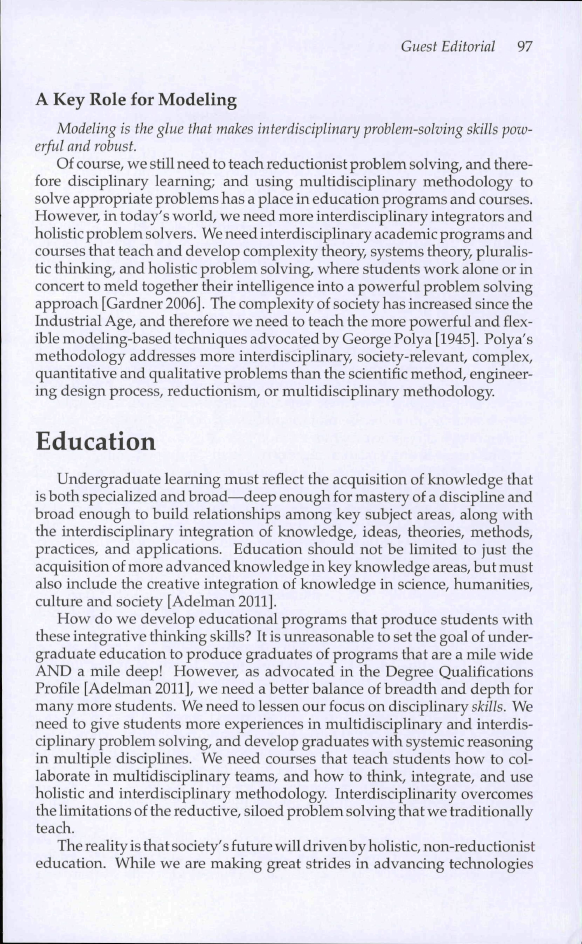
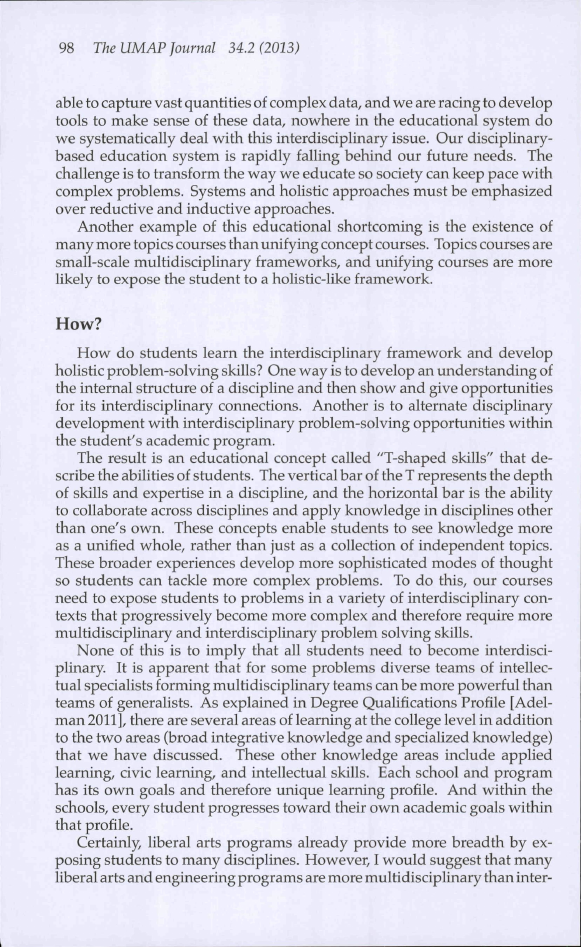
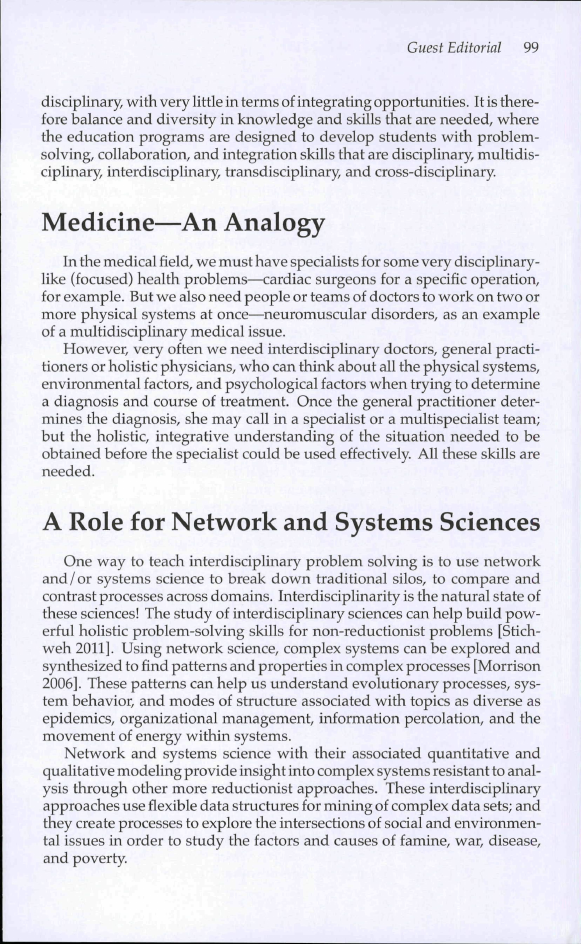
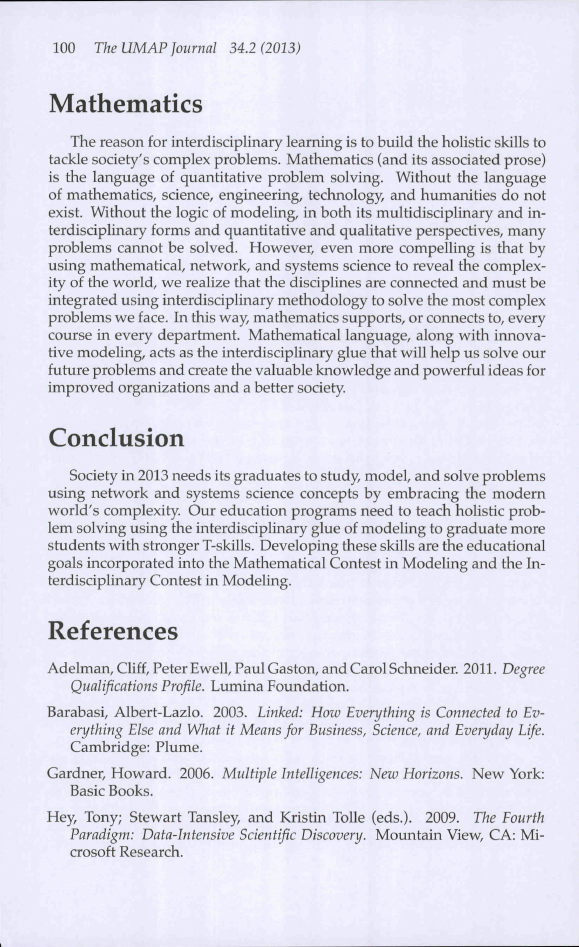








 2023年江西萍乡中考道德与法治真题及答案.doc
2023年江西萍乡中考道德与法治真题及答案.doc 2012年重庆南川中考生物真题及答案.doc
2012年重庆南川中考生物真题及答案.doc 2013年江西师范大学地理学综合及文艺理论基础考研真题.doc
2013年江西师范大学地理学综合及文艺理论基础考研真题.doc 2020年四川甘孜小升初语文真题及答案I卷.doc
2020年四川甘孜小升初语文真题及答案I卷.doc 2020年注册岩土工程师专业基础考试真题及答案.doc
2020年注册岩土工程师专业基础考试真题及答案.doc 2023-2024学年福建省厦门市九年级上学期数学月考试题及答案.doc
2023-2024学年福建省厦门市九年级上学期数学月考试题及答案.doc 2021-2022学年辽宁省沈阳市大东区九年级上学期语文期末试题及答案.doc
2021-2022学年辽宁省沈阳市大东区九年级上学期语文期末试题及答案.doc 2022-2023学年北京东城区初三第一学期物理期末试卷及答案.doc
2022-2023学年北京东城区初三第一学期物理期末试卷及答案.doc 2018上半年江西教师资格初中地理学科知识与教学能力真题及答案.doc
2018上半年江西教师资格初中地理学科知识与教学能力真题及答案.doc 2012年河北国家公务员申论考试真题及答案-省级.doc
2012年河北国家公务员申论考试真题及答案-省级.doc 2020-2021学年江苏省扬州市江都区邵樊片九年级上学期数学第一次质量检测试题及答案.doc
2020-2021学年江苏省扬州市江都区邵樊片九年级上学期数学第一次质量检测试题及答案.doc 2022下半年黑龙江教师资格证中学综合素质真题及答案.doc
2022下半年黑龙江教师资格证中学综合素质真题及答案.doc